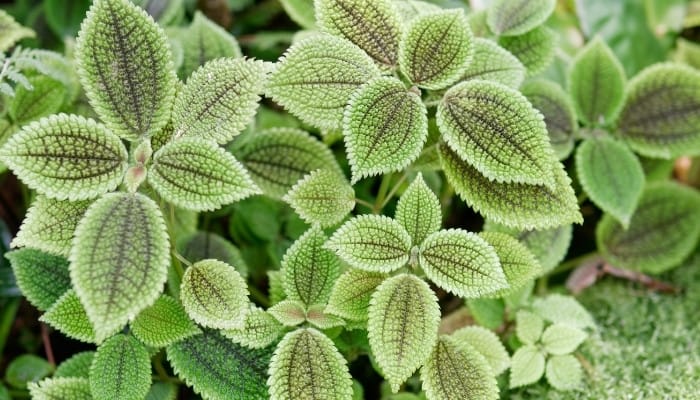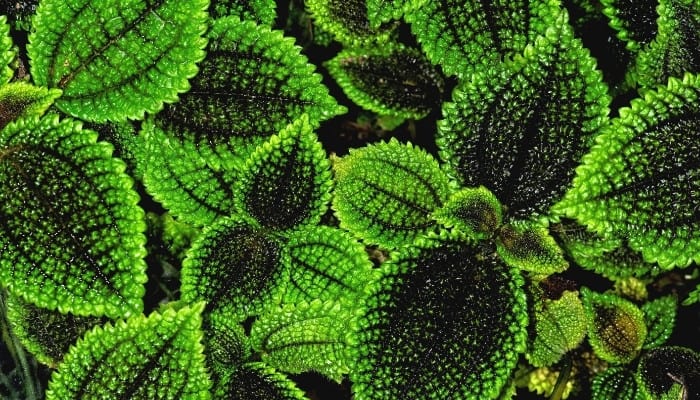The nickname given to this unique houseplant is derived from its dimpled and puckered texture, resembling the craters found on the surface of the moon.
But unlike our monochromatic satellite, moon valley Pilea boasts a bold apple-green surface with contrasting bronze veins, making it a joy to grow indoors if you provide reliably lush conditions.
How do you care for a moon valley Pilea? Pilea mollis ‘Moon Valley’ should be potted in a rich soil full of organic matter and placed in an area with bright, indirect light. Keep the soil evenly moist, and maintain temperatures of 65-75ºF. Fertilize with a diluted houseplant food once in the spring and once in the summer.
Its modest size and intriguing foliage make this plant the perfect little statement piece whether placed on the windowsill or showcased in a terrarium garden.
From its essential care needs to common grower queries and more, this guide will help you raise a happy moon valley Pilea plant!
Caring for Pilea ‘Moon Valley’
These uniquely textured plants rarely grow taller than 1 foot (30 cm), making them fairly manageable, beginner-friendly houseplants.
Pilea ‘Moon Valley’ are not without their eccentricities though, so stay close to their ideal environment to watch them flourish.
Pilea ‘Moon Valley’ at a Glance
- Botanical Name: Pilea mollis ‘Moon Valley’
- Family: Urticaceae
- Key Feature: Deeply textured foliage
- Average Height: 10-12 inches
- Average Width: 6-12 inches
- Growth Rate: Medium
- Lighting Needs: Bright, dappled
- Blooms: Subtle cream/pink blossoms
- Care Difficulty: Easy
Ideal Soil
Moon valley plants benefit from a rich, well-draining potting soil.
An easy premixed base of 2 parts regular potting soil with 1 part succulent soil will suffice.
However, to really invigorate it, author and Master Gardener Jon VanZile advises mixing a special organic-rich blend of “2/3 peat moss with 1/3 leaf mold (composted leaves) and a little added perlite.”
Leaf mold will add benign fungi to the soil to improve its overall structure and nutrient intake, while the perlite (lightweight granular rocks) keeps the soil aerated for improved drainage, which gives your moon valley a fighting chance against root rot.
Lighting Requirements
Bright, indirect light levels are best – plant stores and nurseries can mislabel moon valley plants as “low light lovers,” but too little sunlight will quickly see leaves either drop off or turn darker and produce leggy stems.
East-facing window sills are perfect, though any area of bright sunlight will be fine as long as you have sheer curtains in place for protection and dappled light exposure.
Watering Needs
Moon valley plants prefer evenly moist – not soggy soil, so only water once the top layer of soil feels dry.
Water well, let it drain properly, and don’t water again until the potting mix fully dries out.
Place your fingers in the top 2 inches of soil regularly to be sure, and you can afford to water it less frequently during winter.
Temperature & Humidity
Comfortable home temperatures of 65-75ºF (18-24ºC) will suit this plant perfectly – just be sure to avoid temperature drops below 50ºF (10ºC) by pulling it away from frosty windows and drafts.
Moon valley plants can adjust to 50% humidity but will thrive in higher levels, so do all you can to maintain a tropical environment.
This could mean grouping it together with other humid-loving houseplants, investing in a humidifier, like this quiet cool-mist model, or keeping it in a terrarium.
A terrarium is a favorite choice due to its small, mounding growth habit.
Fertilization
Less is more for optimum health, and the more organic your potting mix (peat based/compost rich etc.), the less it requires feeding.
Andrew Courtney of Smart Garden Guide simply recommends: “fertilizing once in spring and again in summer with a ‘balanced’ houseplant fertilizer diluted to 1/4 strength.”
Take care to only feed your moon valley plant after watering to prevent yellowing foliage and possible root burn.
Does Pilea ‘Moon Valley’ Flower?
Yes, though flowers are insignificant and very rare on indoor moon valley plants, which are usually grown for their showy foliage instead.
Tiny pale pink or cream-colored blossoms appear in tight clusters together midway down the stem and tend to bloom in late spring or early summer and last for several days.
Should I Mist Pilea ‘Moon Valley’?
Moon valleys will benefit from occasional to regular misting and the frequency will depend on the reliability of humidity in your environment.
For instance, in average home temperatures (65-75ºF) and the absence of a humidifier, misting 2-3 times a week is recommended to maintain high humidity.
If you’re a forgetful plant owner, your moon valley plant can tolerate occasional misting (once weekly), but it is best to supplement this with a reliable source of air moisture, such as with a humidifier or humidity pebble tray to prevent stress-induced foliage loss and poor growth.
How Do You Prune Pilea Moon Valley?
As stems become leggy on your moon valley plant, you can pinch them using your thumb and forefinger or cut them just above a leaf node to remove stem length using clean, sharp scissors.
Pileas tend to stretch in low-light conditions, so keep them in brighter sunlight or employ grow lights, like these full-spectrum lights, in darker homes to prevent leggy stems.
Why Is My Pilea ‘Moon Valley’ Drooping?
Drooping foliage is normally a sign of overwatering and possibly too much exposure to direct sunlight.
Feel to see if the top 2 inches of soil are overly moist or soggy, and reduce watering until it dries out.
If drooping still occurs, root rot may have set in, so inspect the root system for dark, mushy areas, and cut off any rotten sections with a sharp, sterile knife.
Wash the root ball and spray with natural fungicide, like this copper fungus treatment, before repotting in fresh soil.
Is Moon Valley Pilea the Same as the Friendship Plant?

Pilea mollis ‘Moon Valley’ is often sold under the name “friendship plant” according to the Missouri Botanical Garden since both plants share the cultivar name ‘Moon Valley’ due to their similar appearance.
However, the friendship plant is a separate variety known as Pilea involucrata, which is slightly smaller at 8 inches tall on average and features less of an upright growth habit compared with Pilea mollis.
Another feature setting the Pilea mollis apart is its softer leaf texture with mollis meaning “cover of soft hairs” in Latin.
The name “friendship plant” references the fact that Pilea involucrata is easy to propagate and share among fellow plant growers, which can be applied to both Pilea varieties in this case.
Is Moon Valley Pilea Toxic?
Moon valley Pilea is a non-toxic houseplant to pets and humans.
Nausea and vomiting are known to occur if the leaves are consumed in large quantities, so keep the plant out of reach of young children and consider spraying the lower leaves with lemon juice or a similarly bitter repellent with especially curious pets around.
When To Repot Pilea ‘Moon Valley’?
Repotting should ideally be done early to mid-spring since the plant can recover more easily from the shock of rehoming in its warm growing season.
As Pilea ‘Moon Valley’ plants have fairly shallow roots, repotting may only be necessary every couple of years. You’ll know it’s time to repot your moon valley when:
- Roots protrude from the pot’s drainage holes/appear in the topsoil.
- It needs watering more than usual.
- The current soil no longer drains as quickly as before.
Should I Remove Pilea Babies?
You can remove Pilea plantlet babies or “pups” to encourage tidier, bushy growth or for propagating (see below).
Otherwise, you can leave them to grow as normal. Pilea babies are offsets that grow from the parent’s rhizome (root structure) and appear right on top of the soil.
Wait until each Pilea baby shoot reaches at least 2 inches tall before removing to ensure it is strong enough to survive transplanting.
Make sure to harvest Pilea babies during the spring-fall growing season to take them in active growth, and remove them by snipping each one at the base of its stem using clean, sharp kitchen scissors.
How To Propagate Pilea ‘Moon Valley’?
Moon valley propagation (creating offspring plants) can be done by rooting the baby cuttings in water or by taking mature stem cuttings from the main mother plant and planting them in fresh potting soil.
Propagation Method 1: Pilea Baby Rooting
- Place each 2-inch baby shoot in a small, clear jar or bud vase of room temperature water and place them in suitably bright, diffused sunlight. Change the water each week to prevent algae growth.
- Allow 3-5 weeks for roots to appear. You can stimulate root growth by placing the cutting ends in natural rooting hormone before putting them into water. Indoor Plants for Beginners host Anya Anthony recommends aloe vera and cinnamon solutions in particular for “warding off fungus and bacteria.”
- Once roots have sprouted, plant your Pilea baby shoots into small containers of your ideal potting soil, and care for them as normal, giving them a thorough watering and allowing excess to drain well.
Propagation Method 2: Replanting Mature Stem Cuttings
- Prune established stems by making a cut at the top 2-3 inches of growth, ensuring each stem contains at least two leaves. Remove any lower leaves for easier transplanting.
- Prepare a small plant pot with moist potting mix – be sure to add a sprinkle of perlite to encourage oxygen flow around the cutting base to minimize the risk of root rot – and plant the stem cutting directly into the soil.
- The cuttings will grow best in initially high humidity. Houseplant pro and influencer Joe Bagley suggests “wrapping the pots in clear plastic to keep things around 75ºF and prevent moisture loss within the stem that will occur with the absence of roots.”
- Remove the plastic bag after 4 weeks. By this time frame (3-6 weeks) foliar growth will be developed and roots should be well established in the pot, allowing you to repot your moon valley stems into larger pots and care for as per the parent plant.
Moon Valley Pilea Common Problems
Common issues with moon valley plants include crisp dropping leaves caused by underwatering, brown leaf tips and yellow lesions or “halos” on the foliage caused by low humidity levels, and excessively yellowing leaves or stunted growth commonly caused by root rot as a result of waterlogged soil.
Prevent these common foliar problems by using a well-draining soil medium that contains perlite to encourage circulation in the soil, watering only when the topsoil dries out, and increasing humidity with misting and humidifiers as needed.
Conclusion
In summary, the Pilea ‘Moon Valley’ plant is an attractive, undemanding plant that requires stable humidity and an observant waterer to keep its statement puckered leaves looking their best.
A soil mix that drains excess moisture is also important for this root-rot-prone houseplant, which can be enjoyed for many years thanks to its simple propagation.
Sources:
https://thebackyardbloom.com/pilea-moon-valley-plant-care/
https://homeguides.sfgate.com/care-moon-valley-plants-42699.html
https://smartgardenguide.com/best-closed-terrarium-plants/
https://www.quiet-corner.com/houseplants-growing-moon-valley-indoors/
https://www.ukhouseplants.com/plants/moonlight-valley-plant
https://smartgardenguide.com/pilea-involucrata-care/
https://www.thesill.com/blogs/plants-101/how-to-care-for-moon-valley-pilea-pilea-mollis
https://bloomscape.com/common-issue/why-is-my-pilea-drooping/
https://thehealthyhouseplant.com/pilea-varieties-information-on-the-most-common-types/
https://thehealthyhouseplant.com/what-to-do-with-pilea-babies-pilea-propagating-101/
https://www.reddit.com/r/houseplants/comments/c3pu1h/whats_wrong_with_my_pilea_mollis_moon_valley/

